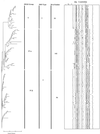Polymorphism of Bordetella pertussis isolates circulating for the last 10 years in France, where a single effective whole-cell vaccine has been used for more than 30 years
- PMID: 11724851
- PMCID: PMC88555
- DOI: 10.1128/JCM.39.12.4396-4403.2001
Polymorphism of Bordetella pertussis isolates circulating for the last 10 years in France, where a single effective whole-cell vaccine has been used for more than 30 years
Abstract
We compared Bordetella pertussis isolates collected in France over the last 10 years, the vaccine strains used for more than 30 years, and isolates collected before the introduction of generalized vaccination. The analysis included serotyping, pulsed-field gel electrophoresis of chromosomal DNA after digestion with XbaI and SpeI, and sequencing of the pt S1 gene, encoding the S1 subunit of pertussis toxin, and the prn gene, encoding the adhesin pertactin. We found that the incidence of infection increases every 3 years. Ninety-five per cent of the isolates analyzed express type 3 fimbriae. Most of the isolates circulating since 1991, unlike the vaccinal strains, express a type A pertussis toxin and a type 2 pertactin. The isolates could be classified into five major groups by pulsed-field gel electrophoresis. Most of these groups correlated with the pertactin type expressed by the isolates. Pulsed-field gel electrophoresis is more discriminative than sequencing particular genes since it could differentiate isolates expressing type 2 pertactin into two subgroups: those circulating in 1993 to 1997 and those circulating in 1997 to 2001. This observation suggests that there has been continuous evolution of the B. pertussis population.
Figures





Similar articles
-
Comparison of the Bordetella pertussis and Bordetella parapertussis isolates circulating in Saint Petersburg between 1998 and 2000 with Russian vaccine strains.J Clin Microbiol. 2003 Aug;41(8):3706-11. doi: 10.1128/JCM.41.8.3706-3711.2003. J Clin Microbiol. 2003. PMID: 12904379 Free PMC article.
-
Pulsed-field gel electrophoresis, pertactin, pertussis toxin S1 subunit polymorphisms, and surfaceome analysis of vaccine and clinical Bordetella pertussis strains.Clin Vaccine Immunol. 2007 Nov;14(11):1490-8. doi: 10.1128/CVI.00177-07. Epub 2007 Aug 15. Clin Vaccine Immunol. 2007. PMID: 17699837 Free PMC article.
-
Genetic and antigenic analysis of Bordetella pertussis isolates recovered from clinical cases in Ontario, Canada, before and after the introduction of the acellular pertussis vaccine.Can J Microbiol. 2005 Oct;51(10):887-92. doi: 10.1139/w05-079. Can J Microbiol. 2005. PMID: 16333349
-
Bordetella pertussis and pertactin-deficient clinical isolates: lessons for pertussis vaccines.Expert Rev Vaccines. 2014 Sep;13(9):1135-46. doi: 10.1586/14760584.2014.932254. Epub 2014 Jun 23. Expert Rev Vaccines. 2014. PMID: 24953157 Review.
-
Molecular Epidemiology of Bordetella pertussis.Adv Exp Med Biol. 2019;1183:19-33. doi: 10.1007/5584_2019_402. Adv Exp Med Biol. 2019. PMID: 31342459 Review.
Cited by
-
Comparative genomics of Bordetella pertussis reveals progressive gene loss in Finnish strains.PLoS One. 2007 Sep 19;2(9):e904. doi: 10.1371/journal.pone.0000904. PLoS One. 2007. PMID: 17878939 Free PMC article.
-
Cytochrome oxidase requirements in Bordetella reveal insights into evolution towards life in the mammalian respiratory tract.PLoS Pathog. 2024 Jul 8;20(7):e1012084. doi: 10.1371/journal.ppat.1012084. eCollection 2024 Jul. PLoS Pathog. 2024. PMID: 38976749 Free PMC article.
-
Studies on Prn variation in the mouse model and comparison with epidemiological data.PLoS One. 2011 Mar 25;6(3):e18014. doi: 10.1371/journal.pone.0018014. PLoS One. 2011. PMID: 21464955 Free PMC article.
-
Virulence of pertactin-negative Bordetella pertussis isolates from infants, France.Emerg Infect Dis. 2013 Mar;19(3):471-4. doi: 10.3201/1903.121475. Emerg Infect Dis. 2013. PMID: 23621904 Free PMC article.
-
Pertussis Epidemiology in Greece and Emerging Risk Groups during the Vaccination Era (1980-2008).Adv Prev Med. 2012;2012:303846. doi: 10.1155/2012/303846. Epub 2012 Sep 16. Adv Prev Med. 2012. PMID: 23019527 Free PMC article.
References
-
- Andrews R, Herceg A, Roberts C. Pertussis notifications in Australia, 1991 to 1997. Commun Dis Intell. 1997;21:145–148. - PubMed
-
- Anonymous. Information—Calendrier vaccinal. Bull Epidemiol Hebdomadaire. 1998;15:61–63.
-
- Baron S, Haeghebaert S, Laurent E, Guiso N. Renacoq: surveillance de la coqueluche à l'Hôpital en 1998. Bilan de 3 années de surveillance. Bull Epidemiol Hebdomadaire. 2000;34:143–146.
-
- Baron S, Njamkepo E, Grimprel E, Begue P, Desenclos J C, Drucker J, Guiso N. Epidemiology of pertussis in French hospitals in 1993 and 1994: thirty years after a routine use of vaccination. Pediatr Infect Dis J. 1998;17:412–418. - PubMed
Publication types
MeSH terms
Substances
LinkOut - more resources
Full Text Sources
Other Literature Sources
Medical

